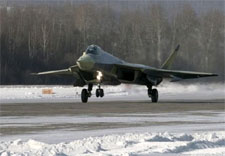|
Moscow: The successful debut test flight of the Russian Sukhoi-designed fifth-generation fighter jet in the Russian Far East on Friday is already creating ripples, including those of the envious kind. The fighter prototype, designated the PAK-FA T-50, is meant to be Russia's answer to the American Lockheed constructed F-22 Raptor.  | | Sukhoi's T-50 fighter taking off for its test flight | Indeed, Western military sources, for long, have referred to it as the 'Raptorski.' The 47-minute flight carried out by Sergei Bogdan, one of Russia's best test pilots, marks the launch of a five year long project that will see two versions of the aircraft being developed. In accordance with the operational doctrines of both air forces, a single-seat version will be developed for the Russian Air Force and a two-seat version for the Indian Air Force. While induction of the single-seat version for the Russian Air Force is slated for 2015, the twin-seat version for the IAF will likely be ready only two years later. The two-seat version is being worked upon by Indian aerospace engineers from the country's Hindustan Aeronautics Ltd (HAL). India and Russia have agreed to co-develop the fighter and share the estimated development costs of $8-10 billion equally. Both nations will also place similar quantum of orders for the production version of the aircraft – approximately 250 aircraft each. The Indians are also entrusted with a 25 per cent share of the design and development work. The Indian version of this advanced stealth fighter is designated the Fifth Generation Fighter Aircraft (FGFA). Following Friday's successful test, Russian prime minister Vladimir Putin has said that initial induction of the aircraft with the Russian Air Force must begin in 2013, even though mass production is slated only for 2015. Speaking to Russian TV from an airfield in Komsomolsk-on-Amur where the company's KnAPPO production facility is located, Sukhoi's director general, Mikhail Pogosian said, "I think this is a new stage in the development of the military aircraft industry in our country, and I believe that this is a very good start of a big work we have yet to do." According to Sukhoi, the T-50 will display "intellectual" capabilities allowing it to fly at any time of the day and in any weather conditions. The aircraft will be capable of simultaneously attacking multiple targets in air, on the ground and in the sea. The plane is also touted to have a very high degree of manoeuvrability and a very short take-off and landing capability. "It will also be less recognizable for radars thanks to many innovations, the use of composite materials and a special coating on the surface of the plane," Suhkoi officials informed the media. They said that the T-50 would now allow them to catch up with the Americans, who developed advanced stealth technologies much before. Predictably, the test flight has drawn a certain amount of scorn from some military observers. They point out that the new prototype doesn't have new engines or electronics and hence cannot qualify to be called a fifth generation fighter, for it is components such as these that allow it to be placed in another generation. They said that the prototype was only a souped up model of the existing Su-27 platform and have characterised the test flight as a ''bluff.'' Not so far back in time, when the Su-27 platform, with its thrust vectoring engines and advanced aeronautic capabilities, was making its first entry into the world of military aviation similar scorn was heaped upon it. It was denied that the aircraft would succeed in displaying the kind of capabilities that the Russians claimed it would. As Russian experts point out even the Su-27 made its first appearance borrowing engines from earlier models. Strangely, the Western air forces now consider it a privilege to be able to take on its advanced variants, such as the Indian Su-30MKI, in air-to-air exercises. For India, the Russo-Indian FGFA will mark a quantum jump in technology development for it will be the first time they will be involved in developing fifth generation technologies as full-fledged partners. Both countries are set to sign commercial contracts and set up a joint venture company to build the aircraft. The BrahMos joint venture model is being kept in mind for this project as well, for it is indeed a successful example of joint venture cooperation As for mutual understandings arrived at so far with regard to the project, India will supply the plane's navigation systems, mission computer, cockpit display, and also provide composites for the airframe. Sukhoi chief is also confident about the cost-effectiveness of the fighter in comparison to its American counterparts –the F-22 Raptor and the F-35 Lightning II. ''The joint Russian-Indian aircraft will not only strengthen the defence might of the Russian and Indian air forces, but will take a worthy place in the world market,'' said Pogosyan. According to Sukhoi, the FGFA will have a radar cross section (RCS) that will be 40 times less than that of the Su-30MKI. While the Su-30MKI has an RCS of about 20 square metres, the FGFA will display an RCS of 0.5 square metres, making it almost invisible to enemy radar. Its ''intellectual'' capability will lie in data fusion, with a wide variety of inputs being electronically combined and displayed to pilots in an easy-to-read form. Data inputs will come from the fighter's infrared, radar, and visual sensors.
|